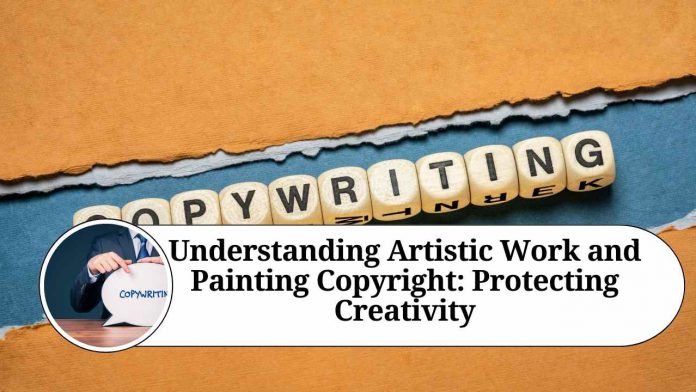Introduction:
Art has the power to captivate, inspire, and evoke emotions. Artists pour their heart and soul into their creative expressions, and it is essential to protect their works from unauthorized use. Copyright laws play a vital role in safeguarding artistic work, including paintings, ensuring that artists can benefit from their creations while encouraging a thriving artistic community. In this blog post, we will delve into the world of artistic work and painting copyright, exploring its significance, the rights it grants, and how artists can protect their creations.
- What is Artistic Work Copyright?
Copyright is a legal concept that grants creators exclusive rights over their original works. In the context of artistic work, copyright provides protection for paintings, sculptures, photographs, illustrations, and other creative visual arts. As soon as an artist creates an original piece, they automatically hold the copyright to that work. The copyright owner has the authority to determine how their work is used and to derive financial benefits from it.
- Rights Granted by Copyright:
Copyright grants artists a bundle of exclusive rights, ensuring control over their creative endeavors. These rights include:
a) Reproduction Right: Artists have the right to reproduce their artwork, meaning they have the authority to create copies, prints, or reproductions of their original piece.
b) Distribution Right: Artists can control the distribution of their artwork, allowing them to determine how it is disseminated, whether through galleries, exhibitions, or sales.
c) Public Display Right: Artists have the right to publicly display their artwork, including exhibiting it in galleries, museums, or other public spaces.
d) Derivative Work Right: Artists hold the right to create derivative works based on their original piece. This means they can create variations, adaptations, or even reproduce their work in different mediums.
e) Attribution Right: Artists have the right to be identified as the creator of their artwork. This right ensures that their name is associated with the work and helps protect their reputation as artists.
- Duration of Copyright Protection:
Copyright protection for artistic works usually lasts for the artist’s lifetime plus a certain number of years after their death. The duration can vary depending on the country, but it typically extends for several decades. During this period, the copyright owner has exclusive control over the work, and others must seek permission to use or reproduce it.
- Protecting Artistic Work Copyright:
To protect their artistic work, painters can take several steps:
a) Copyright Notice: Artists can include a copyright notice on their artwork, consisting of the copyright symbol (©), the year of creation, and the artist’s name. Although not mandatory, a copyright notice can serve as a deterrent against potential infringements.
b) Registration: While copyright protection is automatic, artists may choose to register their artwork with the relevant copyright office. Registration provides additional legal benefits, such as the ability to file a lawsuit for infringement and claim statutory damages.
c) Licensing: Artists can grant licenses to others, allowing them to use their artwork for specific purposes while retaining control and ownership. Licensing agreements can outline the terms, conditions, and compensation for the authorized use of the artwork.
d) Watermarking: In the digital age, artists can protect their work online by watermarking images or using low-resolution versions for display purposes. Watermarks discourage unauthorized use and help identify the original creator.
- Fair Use and Artistic Work:
Fair use is a crucial aspect of copyright law that allows limited use of copyrighted material without permission from the copyright owner. When it comes to artistic work, fair use can be subjective and depends on factors such as the purpose and character of the use, the nature of the copyrighted work, the amount used, and the potential impact on the market for the original artwork.
Other Related Blogs: Section 144B Income Tax Act
Frequently Asked Questions (FAQs)
Q. Do I need to register my artwork to have copyright protection?
No, copyright protection is automatic as soon as you create an original piece of artwork. However, registering your artwork with the relevant copyright office can provide additional legal benefits, such as the ability to file a lawsuit for infringement and claim statutory damages.
Q. Can I use copyrighted artwork for inspiration or reference in my own paintings?
While gaining inspiration from existing artwork is common in the artistic community, it is important to understand the distinction between inspiration and infringement. Copying or reproducing someone else’s artwork without permission can be a violation of copyright law. It is advisable to create your own original work and ensure that it does not substantially resemble or copy another artist’s work.
Q. Can I sell prints or reproductions of my original paintings?
As the copyright owner of your artwork, you have the exclusive right to reproduce and distribute copies of it. Therefore, you can sell prints or reproductions of your original paintings, as long as you have not granted exclusive rights to someone else and there are no other contractual limitations in place.
Q. How can I protect my artwork from unauthorized use on the internet?
To protect your artwork online, consider watermarking your images or using low-resolution versions for display purposes. Watermarks act as a deterrent against unauthorized use and help identify the original creator. Additionally, monitoring your artwork online and promptly addressing any infringements can help protect your rights.
Q. What is fair use in relation to artistic work and painting copyright?
Fair use is a legal doctrine that allows limited use of copyrighted material without the copyright owner’s permission. Fair use is subjective and depends on factors such as the purpose and character of the use, the nature of the copyrighted work, the amount used, and the potential impact on the market for the original artwork. It’s important to consult a legal professional to determine if a particular use falls under fair use or if permission from the copyright owner is required.
Q. Can I incorporate copyrighted images or trademarks in my artwork?
Incorporating copyrighted images or trademarks in your artwork may constitute infringement if you do not have permission from the copyright or trademark owner. However, under certain circumstances, such as transformative use or commentary, your use may be considered fair use. It is advisable to consult a legal professional to understand the specific implications and potential risks.
Q. Can I sell my copyright to someone else?
As the creator and copyright owner of your artwork, you have the right to sell or transfer your copyright to someone else through a written agreement. This agreement, commonly known as an assignment, transfers all or specific rights to the new owner. It is essential to clearly outline the terms and conditions of the transfer to avoid any misunderstandings in the future.




















